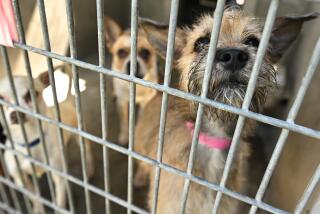
- Share via
- California faces a shortage of professional veterinarians, partly due to high turnover rate in the field and a surge in pet ownership spurred by the pandemic.
- Veterinary students are in high demand but the cost of an education is high and suicide rates among veterinarians is up to four times higher than the general population.
Fourth-year veterinarian student Alexandra Ponkey maneuvered the camera and the surgical tools through the insertions on the belly of a 2-year-old German Shepherd named Jackie.
On her last day as a student, as part of her laparoscopic procedural class, Ponkey took on the role of primary surgeon to spay the dog and remove its ovaries. But before she could cross the graduating stage as a licensed veterinarian, she had to go back into the surgery room — this time as the assistant to another student taking on the job of primary surgeon.
Ponkey, 34, left her first career of teaching and training horse riding and care to achieve her childhood dream of becoming a veterinarian. The hands-on classes at the College of Veterinary Medicine at Western University of Health Sciences in Pomona represented the first step toward achieving that dream.
Today, her new skills are in high demand. As she enters the field, California and the rest of the nation is experiencing a shortage of veterinary professionals due to high turnover rates, rising student debt and a surge in pet ownership spurred by the pandemic, according to John Tegzes, dean of the College of Veterinary Medicine at Western University.

A recent survey by the Society for the Prevention of Cruelty to Animals found that more than 344,000 shelter animals in California do not have adequate access to veterinary care staff. Across the state, about 60% of shelters say they have unfilled veterinarian positions and approximately 54% have unfilled registered veterinarian technicians positions, according to the SPCA.
A Rover dogsitter lost an El Sereno couple’s French bulldog. Two months, a bloodhound and pet psychics later, Gabriella Sidhu is still holding out hope to find Mushie.
The lack of animal medical care has led to overcrowded shelters, a rise in pet illnesses and an increasing rate of adoptable animals being euthanized, according to the survey. The shortage of veterinarians also leads to a lack of medical care available for pet owners, which leads to more animals being surrendered to shelters, according to the survey.
“The pandemic really elevated a crisis that was probably brewing in the background for the last 20 to 40 years, but really accelerated it when many new people adopted pets,” Tegzes said. “The demand for veterinary services started to increase exponentially quickly in Southern California.”
Western University College of Veterinary Medicine is one of only two veterinary schools in California. The U.S. has 33 schools for veterinarian medicine, each with a cap on students being admitted. For Western University, the number of students accepted into its four-year program is limited to 120, Tegzes said. Its 2025 graduating class will see 104 students entering the profession.
Tuition for veterinary students at Western University costs roughly $67,000 per year, which means most graduating students are leaving school with large student debt. Another concern is the high suicide rate among veterinarians.

A 2019 study by the Centers for Disease Control and Prevention showed that veterinarians are as much as four times more likely to die by suicide than the general population. In an interview with National Public Radio, psychologist Kerry Carafa attributed the high rate of suicide in the pet-care field to the balance of care they must shoulder. A veterinarian needs to care not only for the pets, but for the owners and for themselves.
“While social media can be a platform for education, community support, and sharing positive stories, it also has a darker side,” Dr. Karen Lee, medical director of Inland Valley Humane Society, said in an email. “In some cases, dissatisfied clients have used these platforms to publicly attack veterinarians, sometimes sparking viral backlash without the full context being known.”
The Pasadena pet grooming salon is the latest social enterprise of East L.A. organization Homeboy Industries.
Second-year veterinary student Amber Elalem, 30, is well aware of the pressures that come with a job that often results in life-or-death decisions for beloved pets.
“You have to understand that you are going into an industry that you are going to have late nights, you are going to be working longer hours,” Elalem said. “You are going to be doing these things that are going to be taxing you but at the same time you need to make sure you’re taking a little bit of time for yourself as well.
As pet ownership increases, so has the willingness of owners to spend on pet care. That has made investments in veterinarian medicine very popular among corporations and private-equity firms, according to a report by The Atlantic. Corporate-owned clinics see pet care as a viable revenue source, causing prices for visits to increase. Mars Inc., the makers of Skittles and Snickers candies, is the largest owner of stand-alone veterinary clinics in the country, operating more than 2,000 facilities under the names Banfield, VCA, and BluePearl, according to the Atlantic report.
When her 5-year-old Chihuahua, Shrek, became ill, Alejandra Cervantes, an operations associate at Western University, said it was difficult to find care that was both affordable and met her standards.
“Trying to navigate finding [an affordable veterinarian] took a while,” said Cervantes, cradling Shrek in her arms at a coffee shop in Pomona.
As a student, Ponkey has not yet felt as much of the stress that she said she probably will face when she becomes a professional veterinarian. For now, she loves being around animals even when she is unwinding outside of class. She also makes sure to surround herself with a group of mentors who can help her maneuver through the many obstacles of animal medicine and human interaction.
“I think that the students that struggle much less when they get into practice are the ones that live some life beforehand,” Ponkey said. “I find that it’s not necessarily the sciences and the knowledge base that people struggle with as much.”

Ponkey plans to specialize in surgery after finishing veterinarian school, which will require her to work as an intern in a hospital. The salary of a hospital intern is much less than that of a full fledged veterinarian but she points out that she already has paid off her undergraduate tuition with money she earned being a professional equestrian.
“I think that when its your money going towards your education, I think you have maybe a little bit more willingness to have a perspective on how happy am I going to be in this career.”
More to Read
Sign up for Essential California
The most important California stories and recommendations in your inbox every morning.
You may occasionally receive promotional content from the Los Angeles Times.















